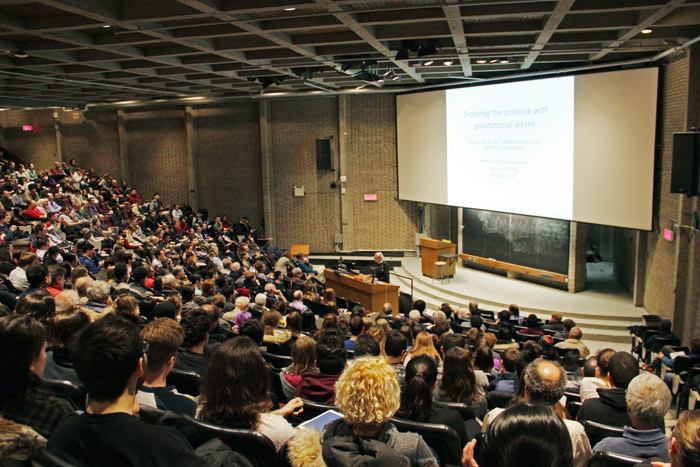On the evening of March 9, Leacock 132 was filled with anticipation and intellectual curiosity as the crowd took their seats to hear Massachusetts Institute of Technology (MIT) Professor Rainer Weiss give the Anna I. McPherson Public Lecture, sponsored by the McGill Department of Physics. Weiss’ presentation was titled “Exploring the Universe with Gravitational Waves” and described how gravitational waves were discovered. Weiss spoke on behalf of the Laser Interferometer Gravitational-Wave Observatory (LIGO) Scientific Collaboration.
Founded in 1997, the LIGO Scientific Collaboration consists of approximately 100 institutions and over 1,000 researchers. In 2016, the collaboration observed the existence of gravitational waves—ripples in the fabric of space and time—for the first time ever.
Weiss conveyed the significance of LIGO’s discovery by speaking to the history and development of physics. He began his story with the father of physics, Sir Isaac Newton.
“What was wrong with Newton that we needed another theory?” Weiss asked.
Newton’s theory didn’t account for the “speed limit” that Einstein’s studies predicted. According to Einstein, there must be a definitive speed of light.
When Einstein began his research in Berlin, his colleagues encouraged him to study quantum theory. Despite their insistence, Einstein chose to study gravity, eventually discovering his theory of special relativity.
“That equation says that the geometry of space and time is determined by the distribution of matter and energy,” Weiss explained in his talk.
Gravitational waves don’t make any noise. They exist in a field of constant strain, stretching space in one direction and compressing space in the other.
To create a measurement device that is able to detect gravitational waves, size matters.
“You want to build something pretty big,” Weiss emphasized.
LIGO finally succeeded in detecting gravitational waves after constructing a mammoth laser detector, consisting of two arms spanning more than a kilometre orthogonal—at right angles—to each other. On each end, there was a mirror that reflected laser beams back and forth along the length of the arms. When a gravitational wave passes through, it alters the space-time in the area changing the phase of the light beams and producing a signal.
The gravitational waves were detected by LIGO after two black holes converged. When the two black holes combined, the event released a ripple in space-time.This collision caused some of the mass of the black holes to be transformed into energy, which was then released as gravitational waves.
“It lost a phenomenal amount of energy,” Weiss explained. “It lost three solar masses into gravitational waves. That was the […] very brightest thing in the universe for a moment. By a factor of 50, the brightest thing.”
This event was recorded by LIGO detectors in Hanford, Washington and Livingston, Louisiana. Due to the successful LIGO measurement of gravitational waves, there are plans for more detectors to be built around the world.
Over 60 years after Einstein’s death, scientists are still confirming and exploring his theories. The measurement and verification of gravitational waves means that LIGO can now fulfill its mission as an observatory, rather than only an experiment. Moreover, with renewed trust in physical paradigms, this is the time to find the answers to the universe.








